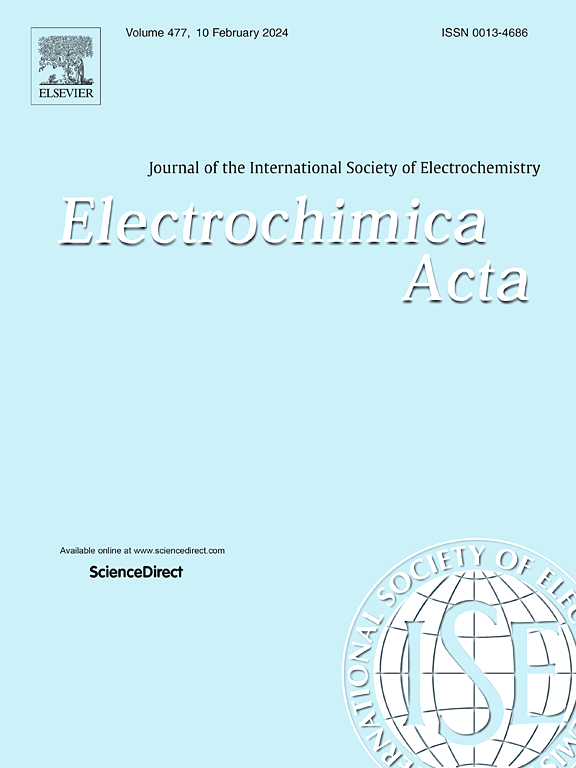Characterization of Ni-GDC based electrolyte-supported cell under processed biogas composition: Electrochemical performance, degradation and recovery
IF 5.5
3区 材料科学
Q1 ELECTROCHEMISTRY
引用次数: 0
Abstract
Biogas-fed solid oxide fuel cell (SOFC) technology based on Ni-GDC electrolyte-supported cell (ESC) offers a sustainable solution for European farms’ heat and power demands with superior efficiency. However, the understanding of the degradation and recovery behavior of the Ni-GDC based ESC under processed biogas environment is limited. This study investigates the responses of various electrochemical processes to the degradation under two cases: (1) cold recirculation before reformer (CB) and hot recirculation before reformer (HB) with no risk of carbon deposition. Chronopotentiometry and current–voltage (IV) results indicated that CB case had the highest degradation rate of -11.6 mV/kh, followed by the HB case with -6.4 mV/kh and the dry H case with -0.42 mV/kh. With the electrochemical impedance spectroscopy (EIS) measurements and distribution of relaxation time (DRT) method, it was found that CB and HB case demonstrated much lower gas conversion resistance than the dry H case, while two peaks representing the electrode gas diffusion process integrated with O surface exchange merged into one peak in HB and dry H case but split in CB case. Complex nonlinear least squares (CNLS) fit was used to quantify the resistance degradation under CB and HB environments, which depended mainly on the ohmic resistance and two electrode charge transfer resistances. The recovery process under dry H environment showed that the total resistance increased after 134 h, validating the degradation inertia under biogas environment, while the time constants of RQ elements and the peak shifting indicated that the electrochemical performance was partially recovering to the initial state. This study provides insights into the long-term performance degradation of Ni-GDC based ESC under processed biogas environment and guidelines to the operating conditions with a lower degradation rate.
基于 Ni-GDC 的电解质支撑电池在加工沼气成分下的特性:电化学性能、降解和回收
基于Ni-GDC电解质支持电池(ESC)的沼气固体氧化物燃料电池(SOFC)技术以卓越的效率为欧洲农场的热能和电力需求提供了可持续的解决方案。然而,对Ni-GDC基ESC在处理沼气环境下的降解和回收行为的了解有限。在无积碳风险的两种情况下,研究了不同电化学过程对降解的响应:(1)炉前冷循环(CB)和炉前热循环(HB)。时间电位测定和电流电压(IV)结果表明,CB的降解率最高,为-11.6 mV/kh,其次是HB,为-6.4 mV/kh,干H22为-0.42 mV/kh。通过电化学阻抗谱(EIS)测量和弛豫时间分布(DRT)方法,发现CB和HB的气体转化阻力明显低于干燥的H22,而代表电极气体扩散过程与O2−2−表面交换的两个峰在HB和干燥的H22中合并为一个峰,而在CB中分裂。采用复杂非线性最小二乘(CNLS)拟合方法定量分析了CB和HB环境下的电阻退化,其中电阻退化主要取决于欧姆电阻和两电极电荷转移电阻。在干燥H22环境下的恢复过程表明,134 h后总电阻增加,验证了沼气环境下的降解惯性,而RQ元素的时间常数和峰移表明电化学性能部分恢复到初始状态。本研究为Ni-GDC基ESC在处理沼气环境下的长期性能退化提供了见解,并为较低降解率的运行条件提供了指导。
本文章由计算机程序翻译,如有差异,请以英文原文为准。
求助全文
约1分钟内获得全文
求助全文
来源期刊

Electrochimica Acta
工程技术-电化学
CiteScore
11.30
自引率
6.10%
发文量
1634
审稿时长
41 days
期刊介绍:
Electrochimica Acta is an international journal. It is intended for the publication of both original work and reviews in the field of electrochemistry. Electrochemistry should be interpreted to mean any of the research fields covered by the Divisions of the International Society of Electrochemistry listed below, as well as emerging scientific domains covered by ISE New Topics Committee.
 求助内容:
求助内容: 应助结果提醒方式:
应助结果提醒方式:


